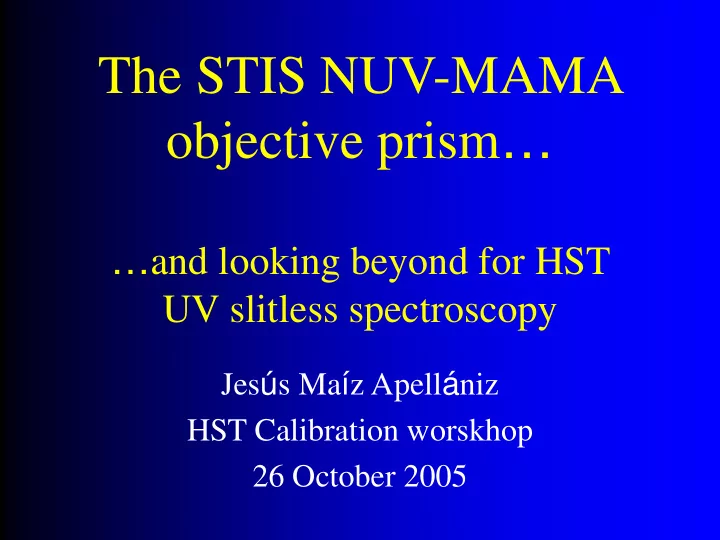

The STIS NUV-MAMA objective prism … … and looking beyond for HST UV slitless spectroscopy Jes ú s Ma í z Apell á niz HST Calibration worskhop 26 October 2005
Outline • The STIS objective prism – Description – Calibration problems • MULTISPEC • Calibration – Flux calibration – Time-dependent sensitivity • Slitless UV spectroscopy with HST
The STIS objective prism NUV FUV
The standard star HS 2027 +0651 with the STIS objective prism 1200 2125
A crowded field with the STIS objective prism
Calibration issues • Sources – Difficulty of wavelength calibration – Lack of “ repeatability ” (~10%) • Diagnostic – Coupling between wavelength and flux calibration: positioning and geometric distortion are crucial – Strong count gradient @ 3300 Å: PSF effects – TDS effects • Solution – Flux recalibration and geometric distortion solution – Ad-hoc solution for λ > 3000 Å – TDS correction
Flux calibration of the objective prism
Calibration issues • Sources – Difficulty of wavelength calibration – Lack of “ repeatability ” (~10%) • Diagnostic – Coupling between wavelength and flux calibration: positioning and geometric distortion are crucial – Strong count gradient @ 3300 Å: PSF effects – TDS effects • Solution – Flux recalibration, separation by settings (1200 and 2125), and geometric distortion solution – Ad-hoc solution for λ > 3000 Å (low precision) – TDS correction
MULTISPEC • Slitless-spectra automatic-extraction IDL code • Profile fitting (with or without residuals) • Requires: – Spectral exposure (objective prism, grism, grating) – Image of the field (two filters) – Image photometry (using e.g. DAOPHOT) – Optional multiple orientations – Calibration files (ready for STIS objective prism) • See http://www.stsci.edu/~jmaiz
Original measured/reference values
Sensitivity correction and TDS solution
New measured/reference values
Summary of precisions • Fit to centered isolated stars: 1 % ( λ < 3000 Å ) 10 % ( λ > 3000 Å ) • Flat-field and variations of the intensity profile across the detector: 3-5 % (lower for isolated stars and dithered data) • Detector: only Poisson (no read noise) • Background: case-dependent but negligible for bright stars • Contamination from nearby spectra: case- dependent
Slitless UV spectroscopy with HST • STIS: – Slitless and 52x2 datasets in the archive (prism, G140L, G230L) – Will STIS become a born-again instrument? • ACS: – HRC (1 objective prism): PR200L – SBC (2 objective prisms): PR110L + PR130L • Possible problems: – Wavelength and flux calibration: yes for prisms (especially PR200L) – Strong count gradient: minor issue for PR200L – TDS effects: yes for SBC, not for HRC (but CTE) • Ongoing calibration programs: – Observations of standard stars with very different spectral slopes and emission line objects (10391,10743) – Observations of crowded, UV-bright clusters (10722, 10736)
A crowded field with ACS/SBC PR130L
Recommend
More recommend